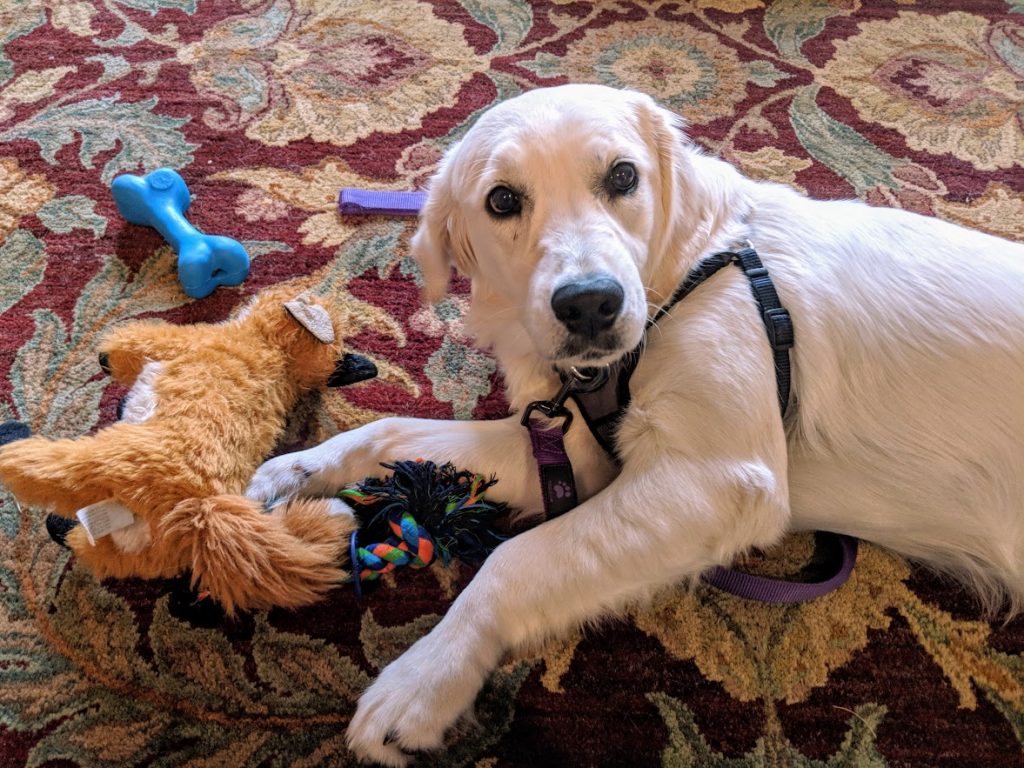Do you have a puppy, or a dog that is out-of-control? How often is your dog on a leash in the house? Yes, I said on leash in the house. This is what trainers call a “tether”, and it is about to make your life a lot easier. Puppies especially require a huge amount of supervision, otherwise they are peeing, chewing on things, and getting into all kinds of trouble. If you are trying to solve a behavior problem with an older dog that only happens when you aren’t looking, like marking, or counter-surfing, the first step is supervision. Depending on the layout of your house it can be really difficult to block off a small area with gates where you can closely supervise your puppy or dog. This is where a tether comes in to save the day.

Two Forms of Tethering
A tether can be stationary, easily made by wrapping a six foot leash around the leg of a heavy piece of furniture, and threading the leash clip through the handle. If you don’t have heavy enough furniture, or you have hardwood floors and a big dog, you can also use a closet door by putting the leash handle on the inside doorknob, and dropping the leash down and under the crack under the door, then closing the door. With a six foot leash, there will be about 3 feet of leash sticking out from under the door where you can tether your dog. Only tether your dog in a location where you can carefully supervise your dog for safety.
You can also use what I call the “umbilical cord” method, where the tether is attached to you. You can either loop the handle of the leash through a belt, or just hold on to the leash, whichever is more convenient for your situation. This is a good option if you move throughout the house a lot, because you don’t want to leave the dog unsupervised on a stationary tether until your training is much further down the road.
Tether Training
It’s important to teach your puppy or dog what you want him to do while on the tether, which is to say, not much. As soon as you snap on the leash, start rewarding the dog for standing still, sitting, or laying down. You want to encourage and reinforce as much calm behavior as possible, so once your puppy/dog picks a position, give treats every few seconds to keep them in that position. Eventually you want to work toward lying down, but sometimes we have to start where the dog can be successful. If your puppy/dog wants to bite at the leash, up your rate of reinforcement so you are rewarding for leaving the leash alone. If you prepare your puppy/dog by teaching them what you do want while they are tethered, you will get more of the behavior you want, and less chewing and pulling.
Creating Rewardable Moments

The beauty of tether training is that it creates the opportunity for the dog to choose the right behavior, while making the wrong behavior harder to do. If your puppy or dog jumps on guests, keep them a leash-length away so that they can’t make contact with the person. When they make the right choice of either sitting, or coming back to you, you can reward them with treats, or the opportunity to greet the guests if they can control themselves! When you can’t control the puppy/dog, you can’t control the misbehavior from happening, so the behavior is practiced. A tether allows you to control what behavior is happening, so you get to chose what gets practiced!
Remember to always supervise your dog while on a tether, they can get easily tangled, especially in the beginning before training has taken effect. If you need help on tether training, and you are in the Northern Colorado area, contact me about In-Home Training. If you are not in my service area, find out more about how to find a trainer here.


